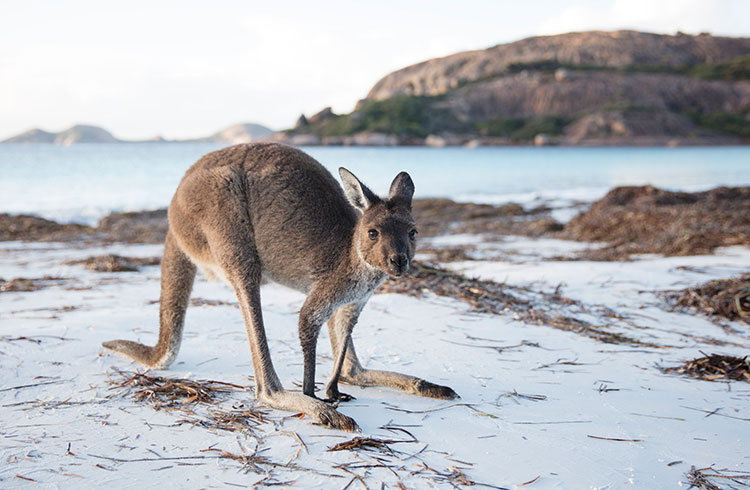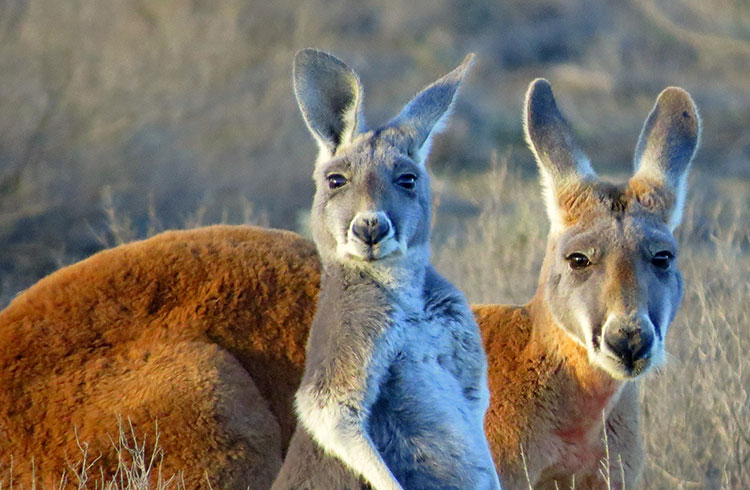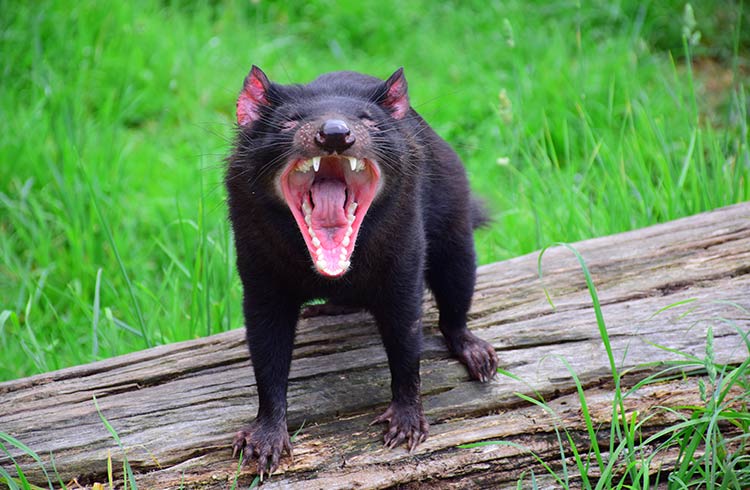Australia’s unique and unusual wildlife has defied notions of what animals are meant to look like, leaving early explorers and naturalists both fascinated and perplexed. Australia is a land where you can see animals found nowhere else.
 Photo © Getty Images/seanscott
Photo © Getty Images/seanscott
While Australia is well-known for its many dangerous creatures, it is also home to some of the world’s most adorable, beautiful, and captivating animals. No matter where your travels in Australia take you, you are certain to come across wildlife you may have thought only existed in the pages of National Geographic.
- Wildlife of the Australian Outback
- Wildlife of Tropical North Queensland
- Wildlife in the Northern Territory
- Wildlife of Tasmania
- Wildlife Around the Cities
Wildlife of the Australian Outback
Most people envision scenes of the Outback when they think of Australia. It’s where mighty Uluru rises from the flame-colored desert, and huge red kangaroos kick up dust as they try to outrun utes along dirt roads. Much of Australia’s interior is made up of arid deserts, but that doesn’t mean it is void of life. If you look closely enough, you’ll notice how alive it really is. Thorny devil lizards move across the sand in search for ants, greater bilbies construct extensive underground tunnel systems, and large perentie goannas prey on just about anything they can catch. Perenties have been known to even take down large wombats, kangaroos, and dingoes.
If you camp out in the Outback, you’ll hear the howls of dingoes echoing across the landscape. It is thought that the dingo is related to an Asian variety of grey wolf, and was introduced to Australia by the Toalean people of Sulawesi around 4,000 years ago. Since then, the dingo has become both loved and loathed. It is believed it played a key role in the decline of many native animal species, such as the mainland devil which went extinct around 3,000 years ago. Its presence also led to the construction of the world’s longest fence, built to protect sheep flocks from attack. In spite of this, it’s a real thrill to see them roam wild in Australia.
You’ll also come across the world’s largest herd of feral camels – dromedary and Bactrian – introduced to Australia in the 19th century from Arabia, India
Other notable invasive species brought to Australia include the red fox and wild rabbits from Europe. Both were introduced to the early Australian colonies for the purpose of

Wildlife of Tropical North Queensland
Australia’s dry Outback interior gives way to the world’s oldest rainforest in Tropical North Queensland. A visit to the Daintree Rainforest is like stepping back into the age of dinosaurs.
You half expect to come across a towering T-Rex but instead, you must settle for the prehistoric-looking cassowary. These flightless birds reach heights of more than 6ft, and the southern cassowaries of Australia can inflict serious injuries with their dagger-like claws if provoked or protecting their young. Unlike most birds, it is the male cassowaries that incubate and care for the young, while the female carries on with her solitary life. While their kick may be dangerous, cassowaries would much rather simply browse the forest floor for various fruits. Give them a bit of space while you admire these giants, with their colorful heads, adorned with crazy looking casques. One of the best places to spot a wild cassowary outside of the Daintree, is at Mission Beach, south of Cairns.
Kangaroos take to the trees in tropical North Queensland where, if you’re lucky, you might catch a glimpse of a threatened Lumholtz's or Bennett's tree-kangaroo. You almost wonder if they are trying to climb to get a better glimpse of the shimmering blue Ulysses Butterfly or vibrantly colored

Wildlife in the Northern Territory
In the wetlands of Kakadu National Park, you’ll discover a land that has been declared a UNESCO World Heritage Site due to its important cultural and natural values. The park is rich with sacred Indigenous sites which include some of the finest ancient rock art in Australia. Much of Kakadu, along with Arnhem Land, is home to one of Australia’s largest Aboriginal Reserves.
The wetlands are home to hundreds of bird species including brolgas, black-necked storks, and vibrant Gouldian finches. You may also come across a frill-necked lizard trying to steal some of the attention when it displays its threatening mane. As darkness falls, giant flying foxes take to the skies to provide a moving concert of sound.
You might feel quite small in the Top End, due not only to the sheer expanse of the landscape but also when standing next to the towering natural skyscrapers created by cathedral termites. These termite mounds can reach 26ft (8m) in height and can remain active for up to 100 years.
Wildlife of Tasmania
Australia’s island state provides the opportunity to see many species which have sadly become endangered or extinct on the mainland. It’s known as the ‘land of the devil ‘after its most notable inhabitant, the Tasmanian devil, a marsupial carnivore with an intimidating personality. Sadly, this once common, and loveable, species has seen a rapid decline in its population due to a detrimental facial tumor disease that has spread across Tasmania.
Thanks to Tasmania’s numerous conservation projects, some devil populations have begun to stabilize. The best area to catch a glimpse of the harmless devils is in the state’s north and northwest. National parks such as Cradle Mountain, Lake St Clair, and Narawntapu provide the best chance to see devils in the wild, while sanctuaries including Hobart’s Bonorong Wildlife Sanctuary and Cradle Mountain’s Devils@Cradle guarantee sightings.
While searching for the devil, you will probably come across the adorable small kangaroo-like pademelon, as well as rodent-like marsupials the potoroo, bandicoot, and

The island is also home to both of the world’s only egg-laying mammals – the duck-billed platypus and the
The state provides the perfect habitat for the platypus in the form of numerous rivers and streams located in towns such as Latrobe and Deloraine in the state’s north. Places like the Tasmanian Arboretum allow travelers to easily witness the antics of the comical creature in the wild without a difficult hike and in broad daylight.
It’s too late to spot one of Tasmania’s most iconic animals, the thylacine or Tasmanian tiger. At one time, these carnivorous marsupials could be found across mainland Australia as well as Tasmania. The last known surviving thylacine died in the Hobart Zoo on September 7, 1936. Although the largest carnivorous marsupial of modern times was declared extinct in 1982, there are claims of sightings of thylacines across Tasmania and mainland Australia, but no indisputable proof, such as remains or photos, has been collected.
Wildlife Around the Cities
You can even find an abundance of wildlife in and around Australia’s largest cities. Car horns and dazzling lights must compete with the raucous cries of sulfur-crested cockatoos and the vibrantly colored plumage of rainbow lorikeets. Dozens of parrot species in all colors light up the city skies as though it were raining Skittles.
The numerous national parks and reserves found around Sydney and Melbourne are home to adorable marsupials including koalas and wombats. Koalas can be spotted by taking a road trip along the world-famous Great Ocean Road, especially around the Kennett River area. Although koalas sleep up to 20 hours a day, you will have to be wide awake to spot the motionless marsupials well camouflaged in the treetops.
The koala’s closest relative, the wombat, is largely nocturnal but can often be spotted in and around river valleys or anywhere where the soil is soft enough for them to dig their burrows. Their backward-facing pouch keeps dirt at bay when entering and leaving their underground homes.
You will have no trouble spotting eastern grey kangaroos around cities like Canberra. Take care when driving through Australia’s “bush capital” as the kangaroos are so plentiful they become road kill on a daily basis. Seeing a mob of kangaroos grazing outside a Canberra shopping mall or in local neighborhoods is not uncommon and makes you feel as though you are in an open-range zoo.
Be sure to keep an eye open to spot several species of blue-tongued lizard, and listen for the comical laughs of the kookaburras that frequent backyards.
Related articles
Simple and flexible travel insurance
You can buy at home or while traveling, and claim online from anywhere in the world. With 150+ adventure activities covered and 24/7 emergency assistance.
Get a quote
No Comments